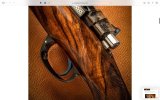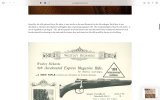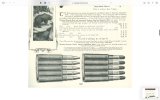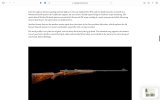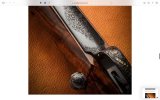- Joined
- Oct 1, 2007
- Messages
- 13,319
- Reaction score
- 9,595
- Website
- www.africahunting.com
- Media
- 5,597
- Articles
- 321
.318 Westley Richards
by Charlie Haley
The .318 Westley Richards is a real old African classic. Largely forgotten today, it was one of the most important of the pre-war sporting calibres. Never, of course, so widely used as the cheap and ubiquitous .303, it was nonetheless one of the most popular of what was termed the 'medium' bore sporting cartridges in the Africa of years ago. It was and still remains a fine choice for the Africa of today.

From left to right: .318 WR, .333 Jeffery, .30-06
The .318 was introduced in 1910, and was intended for Westley Richards sporting rifles with the comparatively new Model '98 Mauser action. This action and rifle was taking the world by storm, and it seemed that anyone who desired to advance himself in the eyes of his peers had to have one of these rifles; even the British army was in the process of trying to dump its Lee-Enfield .303 and adopt a Mauserderivative, along with most of the rest of the world. That they didn't actually manage to loose the Lee-Enfield for another 40 odd years is another story entirely. Suffice to say that a Mauser '98 sporter was the absolute sine qua non of the up-to-the-minute sporting gent, and here it was in a calibre bigger, better and more powerful than the .303. This was the objective all along, of course the .303 with its jacketed bullets and smokeless powder was an absolute revelation compared to black powder and lead bullets, but it quickly became evident that the old .303 was somewhat lacking in some respects, particularly against the heavier soft-skinned species. Furthermore, its rimmed case was an absolute pain in the nether regions when it came to reliable feeding in the later Mauser actions. Well, here was the answer, and the sportsmen of the day adopted it en masse.
The .318 uses a cartridge very similar (in fact, almost identical to) the American .30-06, and in fact it is quite feasible to make .318 cases from .30-06brass. The bullet is of considerably greater frontal area, however, and of a very useful greater weight. Actual bullet diameter is a somewhat confusing .330”, rather than .318 as the title suggests. This comes of the old British habit of commonly (but by no means universally) naming the cartridge by bore rather than groove diameter. The most common bullet weight was 250 grains at a listed speed of 2400 fps, which was by far the most effective and useful combination. A lightweight 180 grainer was offered at an alleged 2700 fps, but proved almost invariably to be a disappointment against all but the lighter species of game. Most of the British gunmakers of that era brought out lightweight bullets at high speed for their bolt-action rifles, so do not think that the Americans alone are guilty of a desire for velocity at all costs! My advice is to stick to the heavier bullet weight; it is more generally useful in Africa, has greater sectional density and most rifles will be sighted for it anyhow.
As stated, the .318 quickly becameimmensely popular in Africa. The 250 grain soft nosed bullets proved extremely effective and penetrative on game, while the solids if properly placed could down an elephant with a brain shot. W. D. M. ('Karamojo') Bell, one of the greatest of the old ivory hunters, used the .318 extensively. Indeed, from my readings, it seems as though he used the .318 at least as much (if not more) than the Rigby 7mm/.275 that he is most famed for using. HOWEVER justbecause Bell shot thousands of elephant with the .318 (and calibres like it), and lived to die of old age, does NOT make the .318 an elephant gun! This was a partial explanation for the eventual downfall of the .318. It became very popular extremely quickly, and is certainly one of those well balanced cartridges that performs out of all proportion to its size and paper ballistics. It was so effective that hunters started to use it against large, thick-skinned, dangerous game animals for which it was never intended. Well placed it would do the trick, but it was found wanting when things went wrong and a charge had to be stopped. Westley Richards themselves would tell you that the .318 was not designed for such stunts; that is what they designed their .425 for, and they would happily sell you one for hunting the big stuff that bit back. Hunters still used their .318's for dangerous game, though, and continued to be knocked about accordingly at times. A certain backlash was inevitable, but the .318 was still so splendidly effective against soft- skinned game that the process was more of a placing of things into perspective. Good as the .318 was, it became recognised that it did in fact have limitations after all, and that one would be well advised to take at least a .375 against the more malevolent species.
Part of the reputation for effectiveness of the .318 was unquestionably due to its being available with some of the bestbullets of the era. Being a Westley Richards calibre, the .318 could be had with soft capped bullets for expansion combined with deep penetration or the LT capped for maximum violent expansion with more limited penetration. Both bullet styles were exclusive to Westley Richards, and were certainly the premium soft noses of their day. I have only heard of one complaint regarding the .318 soft nosed bullets, and that was by a hunter who turned out to be using the light, speedy 180 grainers. He had heard so much about the awesome penetration of the .318, and couldn't understand why he wasn't achieving the same! One other potential problem; both the Westley Richards capped soft point designs superficially resembled solids, and if a shooter who wasn't in the know used a capped soft thinking it was a solid, then disappointment was sure to result.
Rifles chambered for the .318 were, of course, mainly made by Westley Richards on the Mauser action, but this was by no means universal. I have seen a few built upon modified Enfield P-14 actions, or more likely the outwardly identical American P-17. It would be a great deal easier to achieve satisfactory fit and feed for the .318 in an American .30-06 action than the British .303! Although the .318 is normally regarded as a proprietary cartridge (that is, normally only offered by the firm that introduced it), the .318 achieved such popularity that I would regard it as semi-proprietary at best. Mauser offered their 'A' grade rifle in .318 calibre, I once owned a Mauser actioned .318 sporter built by Greener, and recently examined a delightful little take-down .318 rifle by Thomas Bland (called 'The Compactum')! I have heard of a double rifle in .318 calibre (by Holland & Holland, no less) and while I have never seen one, I am certain that there must have been single shot rifles chambered for the .318 (rimless cartridge notwithstanding). There is no doubt that in the sporting fields of Africa during the 1920's and 1930's, a .318 was de rigueur for the knowledgeable hunter. It could be had in standard or take-down configuration from Westley Richards, with standard barrel lengths tending to be on the long side. Most oddly, a lot of .318's from Westley Richards had Metford style rifling. This of course led to worn and eroded bores after a lot of firing with Cordite ammunition. However, when peering down the bore of a .318, don't immediately write it off as irretrievably worn Metford rifling appears shallow and washed out in comparison to conventional lands and grooves, and it may shoot just fine. The .318's main competitor was the .333 Jeffries, also built on the Mauser action and firing a phenomenally long 300 grain bullet at a velocity of 2200 fps. This bullet gained an excellent reputation, and I have heard and read much concerning the popularity of this calibre in Africa. However, while I have examined a great many old .318 rifles, I have yet to even see a .333! It is my considered opinion that .318 rifles outnumbered .333's by a considerable margin in southern Africa.
With all the plaudits and popularity, it seemed that the .318's star would never set. However, World War Two intervened. Afterwards, it would take some years for the British gunmakers to resume sporting rifle manufacture. When they did, it was to find that the hunting fields of the world were now mainly the preserve of the American sportsman. These new nimrods, not unnaturally, wanted American rifles and calibres, and few of them had even heard of the .318. Winchester countered with their excellent .338 Magnum, which is somewhat more powerful than the .318 (which was all to the good as far as the American market went), and all this served to drive the .318 into rapid obscurity. A further clue as to the .318's demise can be gathered by a quick perusal of a 1954 Gun Digest. Westley Richards rifles are catalogued therein, available in various British calibres (including the .318) at a listed price of $400. No doubt it would have to be specially ordered, with the requisite waiting period to consider. In the same publication, however, is the adored Winchester Model 70 in a variety of American calibres, for a mere $120! Even a Super Grade Model '70 with selected walnut stock was only $195.45. Furthermore, .30-06 ammunition was half the price of .318, and a lot more available too. The old British gunmakers, without mass production and with a minimal domestic market, couldn't compete with the American makers as far as cost went. Furthermore, the British rifles were not what the American sportsman wanted at the time. The Brit rifles were hard to 'scope, and telescopic sights were in. Lightweight spitzer bullets at sizzling velocities were gaining popularity, and the English offerings with heavy, round-nosed bullets at moderate speed were out. Eventually Kynoch stopped production of virtually all the old British sporting rifle rounds, and that appeared to be the end of the .318.
Not quite, though. Ironically enough, it was the rifle-conscious Americans who led the revival, and more power to them. Tiring of the magnum craze and the glitzy rifles that went with it, the American sportsman became enamoured of classic cartridges and rifles. The effectiveness of heavy bullets at moderate speed was also re- discovered, and this all coincided with an old-time African hunting revival. Pre-war British rifles found themselves back in style again. A .318 became very much the thing to have, and a fair number of them had ended up in America over the years. Those which had escaped re-barreling were eagerly snapped up, and the Americans, being innovative as well as inveterate reloaders, did not long want for ammunition. Cases could be formed from readily available .30-06 brass, and makers of reloading dies would make whatever one wanted, but bullets continued to be a vexation. The smaller makers of custom bullets would oblige, of course, and .338 bullets could be swaged or ground to size, but the manufacturer who saved the day was Woodleigh of Australia. With impeccable timing, Woodleigh offered a whole range of bullets for a great many of the older British sporting rifles, including the .318. Furthermore, these bullets were of premium quality, taking advantage of all the benefits of modern technology. Bertrams, also of Australia, produce a similar line of high quality, properly headstamped brass cases for obsolete firearms again, included in the line up is the .318. The recently resuscitated line of Kynoch ammunition includes the .318 as well as most of the other old British sporting calibres, and, best of all, perusal of a recent catalogue showed that .318 rifles are once more available from Westley Richards! This splendid old calibre appears to be going from strength to strength, which just goes to prove that while shooting attitudes and fashions change, calibres remain as effective as they always were.
by Charlie Haley
The .318 Westley Richards is a real old African classic. Largely forgotten today, it was one of the most important of the pre-war sporting calibres. Never, of course, so widely used as the cheap and ubiquitous .303, it was nonetheless one of the most popular of what was termed the 'medium' bore sporting cartridges in the Africa of years ago. It was and still remains a fine choice for the Africa of today.
From left to right: .318 WR, .333 Jeffery, .30-06
The .318 was introduced in 1910, and was intended for Westley Richards sporting rifles with the comparatively new Model '98 Mauser action. This action and rifle was taking the world by storm, and it seemed that anyone who desired to advance himself in the eyes of his peers had to have one of these rifles; even the British army was in the process of trying to dump its Lee-Enfield .303 and adopt a Mauserderivative, along with most of the rest of the world. That they didn't actually manage to loose the Lee-Enfield for another 40 odd years is another story entirely. Suffice to say that a Mauser '98 sporter was the absolute sine qua non of the up-to-the-minute sporting gent, and here it was in a calibre bigger, better and more powerful than the .303. This was the objective all along, of course the .303 with its jacketed bullets and smokeless powder was an absolute revelation compared to black powder and lead bullets, but it quickly became evident that the old .303 was somewhat lacking in some respects, particularly against the heavier soft-skinned species. Furthermore, its rimmed case was an absolute pain in the nether regions when it came to reliable feeding in the later Mauser actions. Well, here was the answer, and the sportsmen of the day adopted it en masse.
The .318 uses a cartridge very similar (in fact, almost identical to) the American .30-06, and in fact it is quite feasible to make .318 cases from .30-06brass. The bullet is of considerably greater frontal area, however, and of a very useful greater weight. Actual bullet diameter is a somewhat confusing .330”, rather than .318 as the title suggests. This comes of the old British habit of commonly (but by no means universally) naming the cartridge by bore rather than groove diameter. The most common bullet weight was 250 grains at a listed speed of 2400 fps, which was by far the most effective and useful combination. A lightweight 180 grainer was offered at an alleged 2700 fps, but proved almost invariably to be a disappointment against all but the lighter species of game. Most of the British gunmakers of that era brought out lightweight bullets at high speed for their bolt-action rifles, so do not think that the Americans alone are guilty of a desire for velocity at all costs! My advice is to stick to the heavier bullet weight; it is more generally useful in Africa, has greater sectional density and most rifles will be sighted for it anyhow.
As stated, the .318 quickly becameimmensely popular in Africa. The 250 grain soft nosed bullets proved extremely effective and penetrative on game, while the solids if properly placed could down an elephant with a brain shot. W. D. M. ('Karamojo') Bell, one of the greatest of the old ivory hunters, used the .318 extensively. Indeed, from my readings, it seems as though he used the .318 at least as much (if not more) than the Rigby 7mm/.275 that he is most famed for using. HOWEVER justbecause Bell shot thousands of elephant with the .318 (and calibres like it), and lived to die of old age, does NOT make the .318 an elephant gun! This was a partial explanation for the eventual downfall of the .318. It became very popular extremely quickly, and is certainly one of those well balanced cartridges that performs out of all proportion to its size and paper ballistics. It was so effective that hunters started to use it against large, thick-skinned, dangerous game animals for which it was never intended. Well placed it would do the trick, but it was found wanting when things went wrong and a charge had to be stopped. Westley Richards themselves would tell you that the .318 was not designed for such stunts; that is what they designed their .425 for, and they would happily sell you one for hunting the big stuff that bit back. Hunters still used their .318's for dangerous game, though, and continued to be knocked about accordingly at times. A certain backlash was inevitable, but the .318 was still so splendidly effective against soft- skinned game that the process was more of a placing of things into perspective. Good as the .318 was, it became recognised that it did in fact have limitations after all, and that one would be well advised to take at least a .375 against the more malevolent species.
Part of the reputation for effectiveness of the .318 was unquestionably due to its being available with some of the bestbullets of the era. Being a Westley Richards calibre, the .318 could be had with soft capped bullets for expansion combined with deep penetration or the LT capped for maximum violent expansion with more limited penetration. Both bullet styles were exclusive to Westley Richards, and were certainly the premium soft noses of their day. I have only heard of one complaint regarding the .318 soft nosed bullets, and that was by a hunter who turned out to be using the light, speedy 180 grainers. He had heard so much about the awesome penetration of the .318, and couldn't understand why he wasn't achieving the same! One other potential problem; both the Westley Richards capped soft point designs superficially resembled solids, and if a shooter who wasn't in the know used a capped soft thinking it was a solid, then disappointment was sure to result.
Rifles chambered for the .318 were, of course, mainly made by Westley Richards on the Mauser action, but this was by no means universal. I have seen a few built upon modified Enfield P-14 actions, or more likely the outwardly identical American P-17. It would be a great deal easier to achieve satisfactory fit and feed for the .318 in an American .30-06 action than the British .303! Although the .318 is normally regarded as a proprietary cartridge (that is, normally only offered by the firm that introduced it), the .318 achieved such popularity that I would regard it as semi-proprietary at best. Mauser offered their 'A' grade rifle in .318 calibre, I once owned a Mauser actioned .318 sporter built by Greener, and recently examined a delightful little take-down .318 rifle by Thomas Bland (called 'The Compactum')! I have heard of a double rifle in .318 calibre (by Holland & Holland, no less) and while I have never seen one, I am certain that there must have been single shot rifles chambered for the .318 (rimless cartridge notwithstanding). There is no doubt that in the sporting fields of Africa during the 1920's and 1930's, a .318 was de rigueur for the knowledgeable hunter. It could be had in standard or take-down configuration from Westley Richards, with standard barrel lengths tending to be on the long side. Most oddly, a lot of .318's from Westley Richards had Metford style rifling. This of course led to worn and eroded bores after a lot of firing with Cordite ammunition. However, when peering down the bore of a .318, don't immediately write it off as irretrievably worn Metford rifling appears shallow and washed out in comparison to conventional lands and grooves, and it may shoot just fine. The .318's main competitor was the .333 Jeffries, also built on the Mauser action and firing a phenomenally long 300 grain bullet at a velocity of 2200 fps. This bullet gained an excellent reputation, and I have heard and read much concerning the popularity of this calibre in Africa. However, while I have examined a great many old .318 rifles, I have yet to even see a .333! It is my considered opinion that .318 rifles outnumbered .333's by a considerable margin in southern Africa.
With all the plaudits and popularity, it seemed that the .318's star would never set. However, World War Two intervened. Afterwards, it would take some years for the British gunmakers to resume sporting rifle manufacture. When they did, it was to find that the hunting fields of the world were now mainly the preserve of the American sportsman. These new nimrods, not unnaturally, wanted American rifles and calibres, and few of them had even heard of the .318. Winchester countered with their excellent .338 Magnum, which is somewhat more powerful than the .318 (which was all to the good as far as the American market went), and all this served to drive the .318 into rapid obscurity. A further clue as to the .318's demise can be gathered by a quick perusal of a 1954 Gun Digest. Westley Richards rifles are catalogued therein, available in various British calibres (including the .318) at a listed price of $400. No doubt it would have to be specially ordered, with the requisite waiting period to consider. In the same publication, however, is the adored Winchester Model 70 in a variety of American calibres, for a mere $120! Even a Super Grade Model '70 with selected walnut stock was only $195.45. Furthermore, .30-06 ammunition was half the price of .318, and a lot more available too. The old British gunmakers, without mass production and with a minimal domestic market, couldn't compete with the American makers as far as cost went. Furthermore, the British rifles were not what the American sportsman wanted at the time. The Brit rifles were hard to 'scope, and telescopic sights were in. Lightweight spitzer bullets at sizzling velocities were gaining popularity, and the English offerings with heavy, round-nosed bullets at moderate speed were out. Eventually Kynoch stopped production of virtually all the old British sporting rifle rounds, and that appeared to be the end of the .318.
Not quite, though. Ironically enough, it was the rifle-conscious Americans who led the revival, and more power to them. Tiring of the magnum craze and the glitzy rifles that went with it, the American sportsman became enamoured of classic cartridges and rifles. The effectiveness of heavy bullets at moderate speed was also re- discovered, and this all coincided with an old-time African hunting revival. Pre-war British rifles found themselves back in style again. A .318 became very much the thing to have, and a fair number of them had ended up in America over the years. Those which had escaped re-barreling were eagerly snapped up, and the Americans, being innovative as well as inveterate reloaders, did not long want for ammunition. Cases could be formed from readily available .30-06 brass, and makers of reloading dies would make whatever one wanted, but bullets continued to be a vexation. The smaller makers of custom bullets would oblige, of course, and .338 bullets could be swaged or ground to size, but the manufacturer who saved the day was Woodleigh of Australia. With impeccable timing, Woodleigh offered a whole range of bullets for a great many of the older British sporting rifles, including the .318. Furthermore, these bullets were of premium quality, taking advantage of all the benefits of modern technology. Bertrams, also of Australia, produce a similar line of high quality, properly headstamped brass cases for obsolete firearms again, included in the line up is the .318. The recently resuscitated line of Kynoch ammunition includes the .318 as well as most of the other old British sporting calibres, and, best of all, perusal of a recent catalogue showed that .318 rifles are once more available from Westley Richards! This splendid old calibre appears to be going from strength to strength, which just goes to prove that while shooting attitudes and fashions change, calibres remain as effective as they always were.
Last edited by a moderator:



